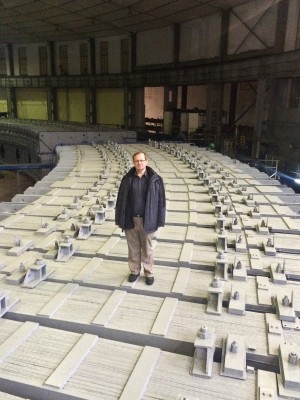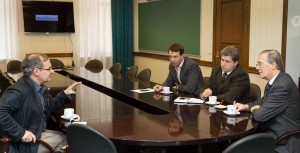
Standing on accelerator history: during his recent trip to Dubna, Brian Foster also visited the Synchrophasotron.
One of the historical characteristics of particle physics is its ability to cross borders and geopolitical power blocks, irrespective of tensions and diplomatic relations. Throughout the Cold War, cordial relations existed between colleagues in the West and the East, with many Russian scientists working at CERN and some CERN scientists working at accelerators in the former Soviet Union. Indeed, this role of science in bringing peoples together was marked this year by the celebration of CERN’s 60th Anniversary at the United Nations in New York, at which Linear Collider Collaboration Deputy Director Hitoshi Murayama gave one of the keynote addresses. Thus I felt entirely comfortably a few weeks ago in travelling to Dubna, 130 km northwest of Moscow, to visit colleagues for discussions about the ILC, despite the current tensions between the US, Europe and Russia.
Of course, in many respects going to the Joint Institute for Nuclear Research (JINR) is not visiting one country, but many. Like CERN, JINR is an international organisation with a large number of member states. It was founded in 1956 with eleven original members, a number which has now grown to 18. In addition there are six associated members, including Germany, Hungary, Italy and Serbia from Europe. The organisation has long had a wide scientific programme, embracing both nuclear and particle physics and has exciting new developments planned for the future, many of which I was able to see during my brief 24-hour visit.
This was my third trip to JINR; the first was in 2006, when I also visited many of the other major accelerator laboratories in the Russian Federation. The entire Global Design Effort also visited in 2008 for a full meeting, in which the proposed Dubna site for the ILC was examined in detail. This included a helicopter ride along the proposed site, never to be forgotten by those who took part. Although these interesting plans for a Russian site have not so far been taken up by the appropriate political authorities, I was delighted to find that JINR still expresses a lively interest in matters relating to linear colliders in general and the ILC in particular.
My host in the morning was an old friend, Grigory Trubnikov, who is now Vice Director of JINR and in charge of the NICA – Nuclotron-based Ion Collider fAcility – project. This is an ambitious and flexible collider based on superconducting technology to study the quark-gluon plasma. It will be able to collide heavy ions in the range 4 – 11 GeV centre-of-mass energy and also produce extracted beams of protons, ions and polarised protons and deuterons. We visited the site, now cleared of the dense forest that surrounds most of Dubna and ready for the construction work to begin in earnest. I was also given a tour around the facility in which the superconducting magnets are being constructed. I was particularly interested to visit the Synchrophasotron. This weighs 36,000 tons and remarkably the iron remains intact almost 60 years after its construction. In perhaps the most remarkable example of the wisdom of “never throw anything away, you will eventually need it”, this iron will be used to shield the 660-MeV booster which will be the injector for the NICA collider. Since I was giving a lecture the following week in which I mentioned the Synchrophasotron as part of the history of accelerator physics – it was the last major “weak-focussing” machine – I was delighted when Grigory photographed me on top of the accelerator.
In the afternoon I was escorted by Dr Dimitry Kamanin, Head of the International Cooperation Department, to a variety of locations, including the enormous cyclotrons where many specialised commercial activities take place. In addition I was able to inspect the substantial progress in the refurbishment of the linear accelerator that I first visited in 2006 and the preparations for a new facility for the training of students from the JINR member states.
The main business of the visit was an hour-long discussion with the Director of JINR, Professor Victor Matveev. I summarised the current status of the ILC and the discussions going on related to a possible site in Japan. Professor Matveev reiterated the interest of JINR in continuing involvement in ILC despite the fact that the NICA project is absorbing a very substantial fraction of the Institute’s resources. He saw the support of JINR for ILC in the framework of international large projects in particle physics and hoped also for growing involvement of other countries in NICA. We discussed options for exploring Russian engagement in possible future ILC construction. I was also very pleased to offer help and collaboration with the celebrations on the occasion of the 60th anniversary of JINR in 2016, for which plans are already well advanced.
It was a great pleasure to be able to return to Dubna even though my visit was rather short. I am always impressed by the enthusiasm of the scientists, the extent of the facilities and the ambitious plans for the future. The coming 60th anniversary is indeed a major milestone in an organisation that is a long-standing and valued collaborator in ILC and has made major contributions to modern physics.



Recent Comments